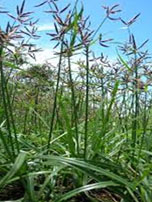SHAHEED KARTAR SINGH SARABHA AYURVEDIC MEDICAL COLLEGE & HOSPITAL
Affiliated to Guru Ravidas Ayurved University, Hoshiarpur Punjab
Affiliated to Guru Ravidas Ayurved University, Hoshiarpur Punjab

Botanical Name : Cyperus rotundus Linn.
Family : Cyperaceae
Introduction :
Musta used in skin infections, vachikarana drug, liver & lung diseases. Root powder is used for epilepsy. Decoction is used in gonorrhoea and also in syphilitic infections
Names in different Indian languages :
English : Nut Grass
Hindi : Motha, Nagarmotha
Kannada : Tungegadde, tungahulli, badramusti
Malayalam : Muttangha
Sanskrit : Musta, mustaka
Tamil : Muthakach, Korai
Telugu : Tunga mustalu;
Unani : Naagarmothaa, Saad-e-Kufi
Synonyms :
Mustaka, Abda, Ambuda, Ambhoda, Ambodhara, Bhadra, Bhadraa, Bhadramusta, Bhadramustaa, Bhadramustaka, Ghana, Jalada, Jaldhara, Meghaahvaa, Nirada, Vaarida, Vaarivaaha, Payoda, Balaahaka. Ganda-Duurvaa
Classification according to Charaka, Susrutha & Vagbhata :
Charaka
Lekhaniya, Trsnãnigrahana, Kandughna, Stanyasödhana
Susrutha
Mustãdi, Vacãdi
Vagbhata
Mustãdi, Vacãdi
Varieties & adulterants – (CV – controversy, AD – adulterants) :
1. Nagara Mustã— C. scariosus (Nut hedge)
2. Bhadra Mustä— C. rotundus (Nut grass)
3. Kaivarta or Jala Mustã— C. esculentus (Earth almond).
C. esculentus
C. esculentus
Kyllinga bulbosa
cyperaceae-kyllinga bulbosa.JPG
Kyllinga monocephala
Morphology :
Perennial slender herb.
Stem— at base nodosely thickened and suddenly constricted into rhizome, subsolitary, triquestrous at top.
Leaves— long, often overtopping stem.
Flowers—, in. compound. umbel, spikes loosely spicate of 3- 8 spikelets.
Seeds— trigonous nuts.
Habitat & Distribution :
Common in rice fields, low lands, water logged places throughout India. s
Chemical Constituents :
Cineol (+) copadiene, copaene, cyperen I & II, cyperenone, isopatchoulenone, cyperotundone, cyperol, cyperolone, a-cyperone, (+) epoxyguaiene, isocyperol, isokobusone, kobusone, mustakone, patchulene, (+) rotundone, selinene, sugenol, beta-sitosterol etc.
Properties :
Rasa Tikta, Katu, Kasaya
Guna Laghu, Ruksa
Virya sita
Vipaka Katu
Karma Kapha-pitta hara, Dipana-Pãcana, Grãhi, Lekhana
Carminative, astringent, anti-inflammatory, antirheumatic, hepatoprotective, diuretic, antipyretic, analgesic, hypotensive, emmenagogue , nervine tonic
Indications : Jvara, Krimi, Trsnã, Atisra, Kandu, Grahani, Kãsa, Nidranãsa, Rakta vikara. Visarpa. Apasmara, Kustha.
Fever, skin disease, intestinal worms, ulcer, diarrhea, dysentery
Part Used :
Tubers
Dosage :
Powder 3-6 g; decoction 50-100 ml.
External uses :
Deodorant, corrosive when applied and rubbed on the skin and as a galactagogue when applied on the breast. In obese patients, powder is used for massage. Local application helps in skin disorders as well as in eye diseases.
Internal uses :
Nervous system : Brain and nervine tonic, hence its paste alone with milk is given in brain impairment and convulsions. –
Digestive system : Mustak is the best medicine for digestive system. Being bitter, it is appetizer, digestive, astringent, anthelmintic and antidiabetic. Hence it is used in anorexia, vomiting, indigestion, sprue and diarrhoea. Large dose is required for expelling worms. A mixture of mustak, karkatshringi and ativisha is good for infantile digestive disorders (balsanjivani churna).
Circulatory system : It is useful in blood disorders by enhancing rakta dhadu.
Respiratory system : It is found to be useful in respiratory disorders arising out of gastrointestinal pathology.
Urinary system : Diuretic, hence useful in dysuria, mainly when it is associated with digestive disorders,
Reproductive system : It is known to promote uterine muscle contractions and also breast milk purifier and promoter. Hence it is used in treating number of gynecological and post-partum conditions.
Skin : it is useful in number of skin disorders viz. pruritus, scabies and oedema etc. Temperature control. Even the Ayurvedic texts and senior Ayurvedic physicians say that mustak is the first drug which should be used in any type of fever.
Satmikaran : Useful as a general tonic and antidote. It is used as a rasayan in teething period with Karkatasrngi, ativisha and pippali.
Important Yogas or Formations :
Mustakadi kadha. Balasanjivani churna, Shadangodak Mustãrista, Gangädhara cürna, Sadanga paniyam, Mustãdivati, Mustadi Kaãya, Mustakãdi curna, Kandarpasundararas.
Important research work going on :
(1) estrogenic activity.
(2) Action on uterus
(3) anti-bacterial activity
(4) Diuretic effect
(5) tranquillizing activity
(6) Action on heart muscles
(7) anti-inflammatory activity
(8) anti-fungal activity
(9) hydrocortisone activity
(10) Action on CNS
(11) Anti cancerous effect.
Therapeutic Uses :
(I) Jvara— Mustã and Parpãtaka are used either with Sunthi or Goksura in the form of infusion (A.H.Ci.).
(2) Atisãra— Decoction of Mustã given with honey (S.S.Ut.)
(3) Halimaka— Loha bhasma, Mustã powder are administered with the decoction of Khadira (B. P.).
